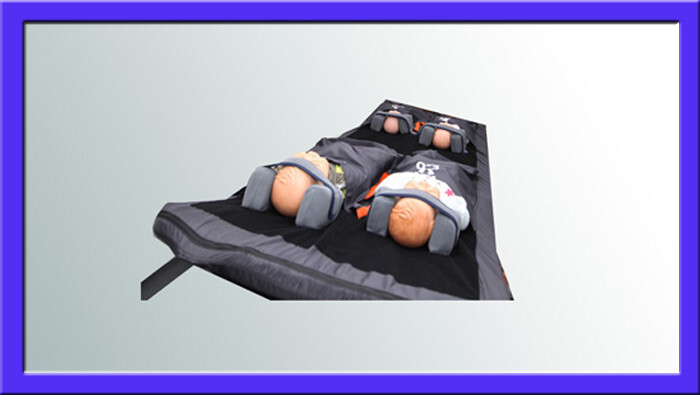What is an evacuation mattress and why is it important for childcare?
An evacuation mattress is an essential safety tool used in childcare settings to ensure the safe evacuation of babies during emergencies. It is designed to provide a secure and comfortable surface for babies to be transported from a building to safety. The purpose of an evacuation mattress is twofold: to facilitate the safe evacuation of babies and to protect them from potential injuries during the process.
Using an evacuation mattress in childcare settings offers numerous benefits. Firstly, it allows for the safe and quick transport of babies, ensuring that they are moved efficiently in emergency situations. Secondly, these mattresses are specifically designed to provide comfort and support to babies, allowing them to remain calm and relaxed during the evacuation process. Lastly, an evacuation mattress provides a safe and secure space for babies, reducing the risk of injuries during transport.
During emergencies, an evacuation mattress plays a crucial role in ensuring the safety of babies. It allows caregivers to safely and quickly transport multiple babies at a time, reducing the time required to evacuate the entire group. The mattress is equipped with hook and loop fasteners that securely hold the babies in place, preventing them from falling off during the evacuation. Furthermore, the evacuation mattress can be easily removed from the wall cover, allowing for efficient and speedy evacuation.
What specification to consider when choosing an evacuation mattress for childcare
When choosing an evacuation mattress for childcare, there are several important specifications to take into account. Firstly, ensure that the mattress provides sufficient comfort and support for babies. Look for a mattress that has a foam mattress with a soft cover to ensure maximum comfort. Additionally, consider the durability and quality of the mattress. It should be able to withstand frequent use and be made from high-quality materials that are easy to clean and sanitize.
Another factor to consider is the ease of use and storage. Look for an evacuation mattress that can be easily removed from the wall cover for quick evacuation. It is also important to ensure that the mattress is lightweight and portable, allowing for easy transportation during emergencies. Lastly, check if the mattress meets all safety standards and regulations set for childcare facilities.
How to safely evacuate babies using an evacuation mattress
Evacuating babies using an evacuation mattress requires proper knowledge and technique. To safely secure a baby on an evacuation mattress, a warden should, in addition to their regular training, follow these step-by-step instructions:
- Place the baby on the mattress, ensuring their head is towards the top.
- Wrap the blanket around the baby, covering them completely.
- Secure the blanket with the hook and loop fasteners, making sure it is snug but not too tight.
- Hold the handles of the evacuation mattress firmly and carry it in an upright position.
- Proceed with the evacuation, taking slow and steady steps.
- When reaching the safe area, carefully release the hook and loop fasteners and unwrap the baby from the blanket.
It is important to remember that during evacuations, time is of the essence. Caregivers should be able to safely and quickly transport multiple babies at a time. This can be achieved by practicing and developing a systematic approach to carrying and transporting babies on evacuation mattresses. For example, caregivers can carry two kids at a time, one on each side, to maximize efficiency.
When using hook and loop fasteners to secure babies on an evacuation mattress, always follow the manufacturer’s instructions. The fasteners should be checked regularly for any signs of wear and tear. Additionally, ensure that the evacuation mattress is properly maintained and regularly inspected to ensure its functionality and safety.
Preventing hypothermia during the evacuation process
During evacuations, babies are at risk of developing hypothermia due to exposure to cold temperatures. Hypothermia can have serious consequences on a baby’s health and well-being. To prevent hypothermia during the evacuation process, it is important to take certain precautions.
Ensure that the evacuation mattress provides insulation and warmth for babies. Look for a mattress that has a wall cover specifically designed to protect against cold temperatures. The wall cover acts as a barrier, reducing heat loss and helping to keep babies warm and protected. Additionally, consider providing extra blankets or layers of clothing to further insulate and shield babies from the cold.
Moreover, caregivers should be trained in recognizing the signs and symptoms of hypothermia in babies. This includes pale skin, shivering, lethargy, and a decrease in body temperature. If any of these signs are observed, immediate action should be taken to warm up the baby and seek medical assistance if necessary.
Tips for maintaining and cleaning an evacuation mattress
Maintaining and cleaning an evacuation mattress is vital to ensure its longevity and functionality. Here are some essential tips for proper maintenance and cleaning:
Regularly inspect the evacuation mattress for any signs of damage or wear and tear. Check the foam mattress for any deformities or tears, and replace it if necessary. The cover of the evacuation mattress should be washed regularly to maintain hygiene and cleanliness. Follow the manufacturer’s instructions for washing the cover and ensure that it is completely dry before reuse.
It is recommended to inspect and replace evacuation mattresses periodically, depending on their usage and condition. This will ensure that the mattresses remain in good working order and meet safety standards. Proper storage practices should also be followed to prolong the lifespan of an evacuation mattress. Store the mattress in a dry and clean place, away from direct sunlight and extreme temperatures.
